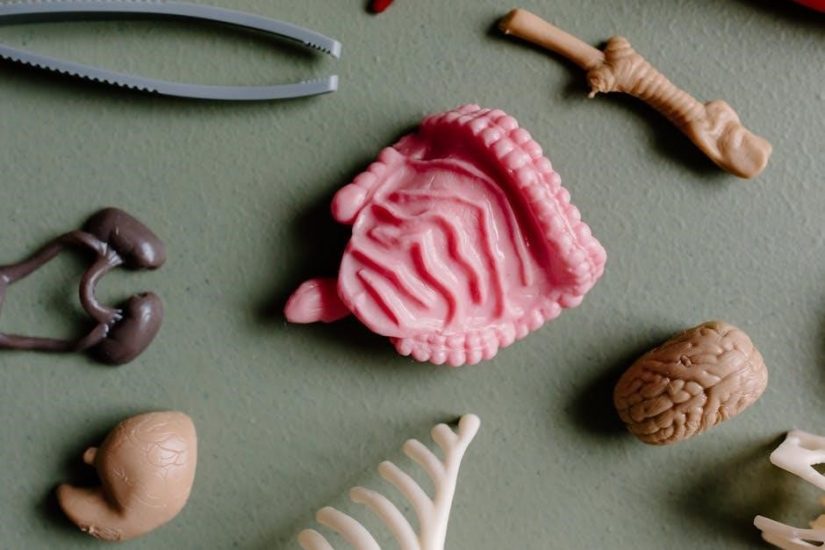This manual serves as a comprehensive guide for biology students, detailing procedures, safety protocols, and essential techniques to conduct experiments effectively and responsibly in a lab setting.
What is a Biology Laboratory Manual?
A biology laboratory manual is a detailed instructional guide designed to assist students in conducting biological experiments and investigations. It provides step-by-step procedures, safety protocols, and essential techniques for laboratory work. The manual serves as a practical supplement to textbooks and lectures, helping students connect theoretical concepts with hands-on experiments. It typically includes sections on lab safety, equipment usage, data collection, and report writing. By following the manual, students can perform experiments effectively, such as microscopy or DNA analysis, while adhering to scientific standards and practices. It is an indispensable resource for biology education and research.
The Importance of a Laboratory Manual in Biology
A laboratory manual is essential for providing structure and consistency in biological experiments. It ensures students follow standardized procedures, promoting accuracy and reproducibility. The manual emphasizes safety protocols, reducing risks and fostering a secure learning environment. By detailing step-by-step instructions, it helps students develop practical skills and scientific reasoning. Additionally, it guides proper data collection and analysis, preparing students for reporting and presenting their findings. This resource is vital for aligning theoretical knowledge with hands-on experience, making it indispensable in biology education and research.
Structure and Organization of a Typical Biology Lab Manual
A biology lab manual is organized into clear sections, starting with an introduction that outlines its purpose and scope; It includes safety protocols, detailing procedures to ensure a secure environment. Subsequent chapters cover essential laboratory equipment, basic and advanced techniques, and experimental design. Data collection and analysis methods are also provided, along with guidelines for writing lab reports. Troubleshooting sections address common issues, and appendices offer supplementary resources like safety data sheets and measurement charts. This structured format ensures clarity and accessibility for students and researchers, facilitating effective learning and experimentation.
How to Use This Manual Effectively
To maximize the benefits of this biology lab manual, students should approach it systematically. Begin by reviewing the introduction to understand the manual’s structure and objectives. Familiarize yourself with safety protocols before starting any experiment, as adhering to these guidelines is crucial for a safe learning environment. Use the detailed instructions and diagrams provided for each technique to ensure accuracy. Regularly refer to the appendices for quick access to supplementary materials, such as conversion tables and safety data sheets. By following these steps, students can enhance their laboratory experience and achieve their learning goals effectively.

Essential Laboratory Safety Protocols
Adhering to safety guidelines is crucial in biology labs. Wear PPE, handle equipment and chemicals carefully, and follow emergency procedures to ensure a safe working environment for everyone.
General Safety Guidelines in a Biology Lab
General safety guidelines in a biology lab emphasize the importance of personal protective equipment (PPE), such as lab coats, gloves, and goggles, to minimize exposure to hazardous materials. Students should familiarize themselves with emergency exits, fire extinguishers, and eyewash stations. Proper handling of sharp objects, biological specimens, and chemicals is essential to prevent accidents. Additionally, no eating or drinking is allowed in the lab, and long hair or loose clothing should be secured. Finally, waste disposal must follow specific protocols to ensure environmental and laboratory safety. Adhering to these guidelines helps maintain a secure and efficient working environment.
Handling Biological Specimens and Chemicals
Handling biological specimens and chemicals requires careful attention to safety protocols. Biological specimens should be treated with gloves to prevent exposure to potential pathogens, while chemicals must be managed with tongs or gloves to avoid skin contact. Proper storage in labeled containers and adherence to material safety data sheets (SDS) is essential. Specimens should be transported in sealed containers, and chemicals should be handled in well-ventilated areas. Dispose of waste separately for biological and chemical materials, following lab guidelines. Always decontaminate surfaces after use and wash hands thoroughly after handling specimens or chemicals. Emergency procedures should be understood in case of spills or exposure.
Emergency Procedures in the Lab
In case of emergencies, immediate action is critical. For fires, use fire extinguishers suitable for the type of fire. Spills of hazardous chemicals should be contained using spill kits, and the area evacuated. Injuries, such as cuts or burns, require immediate first aid. Eye exposure to chemicals demands flushing with water for at least 15 minutes. If biological specimens are involved, decontaminate with appropriate agents. Alert lab personnel and follow evacuation protocols if necessary. Always know the location of safety equipment like eyewashes, fire extinguishers, and first aid kits. Prevention and preparedness are key to minimizing risks and ensuring a safe lab environment.
Waste Disposal in a Biology Laboratory
Proper waste disposal is essential to maintain a safe and environmentally responsible lab environment. Biological waste, such as cultures or specimens, must be autoclaved or decontaminated before disposal. Chemical waste should be segregated by type and disposed of according to local regulations. Sharps, like needles, require specialized containers to prevent injury. Recyclable materials should be separated and processed appropriately. All waste must be labeled clearly, and disposal methods should follow established safety protocols to prevent contamination and environmental harm. Lab personnel are responsible for adhering to these guidelines to ensure compliance with safety and regulatory standards.

Common Laboratory Equipment and Tools
This section introduces essential laboratory instruments, such as microscopes, centrifuges, and pipettes, explaining their functions and proper usage in biological experiments and analysis.
Microscopes: Parts, Usage, and Maintenance
A microscope is a fundamental tool in biology, consisting of eyepieces, objective lenses, a stage, and a condenser. Proper usage involves preparing slides, focusing the sample, and adjusting lighting. Maintenance requires regular cleaning, storing in a dry place, and ensuring lens clarity. Understanding its parts and care is essential for accurate observations and extending the instrument’s lifespan. Always follow safety guidelines and manufacturer instructions for optimal performance and longevity of the microscope.
Measurement Tools in Biology: Pipettes, Burettes, and More
Pipettes, burettes, and graduated cylinders are essential for precise liquid measurements in biology labs. Pipettes, including micropipettes, accurately transfer small volumes, while burettes measure larger quantities for titrations. Calibration is crucial to ensure accuracy. Proper handling and maintenance, such as regular cleaning, prevent contamination and errors. These tools are vital for experiments requiring exact measurements, making them indispensable in biological research and experimentation. Always follow specific techniques to achieve reliable results and maintain instrument longevity.
Thermal Equipment: Incubators, Water Baths, and Heat Plates
Thermal equipment like incubators, water baths, and heat plates are crucial for maintaining precise temperature conditions in biology labs. Incubators are used for cell cultures, microbial growth, or enzymatic reactions, providing consistent heat. Water baths offer uniform temperature control for heating or cooling samples. Heat plates are essential for heating solutions to specific temperatures. Proper calibration and maintenance ensure accuracy and safety. These tools are vital for experiments requiring controlled thermal environments, enabling precise biological processes and reliable results. Always follow safety protocols when operating thermal equipment to avoid accidents and ensure optimal performance.
Other Essential Lab Equipment: Centrifuges, Microcentrifuges, and Autoclaves
Centrifuges and microcentrifuges are used to separate substances of varying densities by spinning at high speeds, essential for processing biological samples. Autoclaves sterilize equipment and materials using high-pressure steam, ensuring contamination-free environments for experiments. These tools are critical for maintaining precision and safety in biological procedures. Regular maintenance and proper operation are vital to ensure functionality and longevity. Understanding their roles and handling them correctly is fundamental for successful laboratory work in biology.
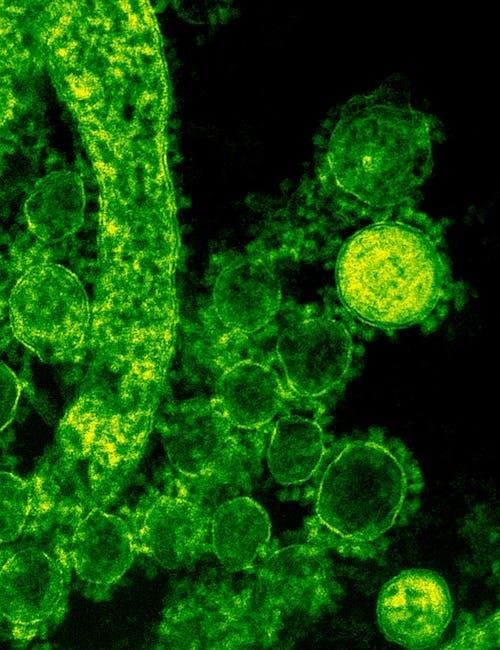
Basic Laboratory Techniques
Mastering fundamental lab techniques like measurement, solution preparation, sterilization, and microscopy forms the cornerstone of biological experimentation, ensuring accuracy and reproducibility in scientific investigations.
Measurement and Calibration of Instruments
Accurate measurement and calibration of instruments are critical in biological experiments to ensure reliability and reproducibility of results. This involves understanding the proper use of tools like pipettes, thermometers, and spectrophotometers. Calibration ensures instruments provide precise readings, while regular maintenance prevents errors. By following standardized protocols, students can master these techniques, enhancing experimental accuracy and consistency. Proper handling and recording of data are essential for valid outcomes. Regular checks and adjustments ensure instruments remain functional and reliable, making measurement and calibration foundational skills in any biology lab setting.
Preparation of Solutions and Reagents
Preparation of solutions and reagents is a fundamental skill in biology labs, ensuring experiments are conducted accurately. This involves measuring solutes and solvents precisely, dissolving substances thoroughly, and verifying concentrations. Proper techniques prevent contamination and ensure solution stability. Labeling and dating solutions are critical for organization and safety. Following established protocols guarantees consistency and reliability in experimental results. Regular practice enhances proficiency, making solution preparation a cornerstone of laboratory work. Always refer to safety data sheets and guidelines when handling chemicals to maintain a safe working environment.
Sterilization and Aseptic Techniques
Sterilization and aseptic techniques are critical in biology labs to prevent contamination and ensure accurate experimental results. Common methods include autoclaving, UV light exposure, and flame sterilization. Aseptic practices involve proper handwashing, gloving, and working in sterile environments like laminar flow hoods. These techniques are essential for handling microorganisms, cell cultures, and sensitive materials. Proper sterilization ensures equipment and solutions remain free from pathogens, while aseptic procedures minimize cross-contamination. Mastery of these methods is vital for maintaining the integrity of biological experiments and safeguarding lab safety. Regular training and adherence to protocols are necessary to uphold these standards effectively.
Basic Microscopy: Slide Preparation and Staining
Slide preparation involves cleaning glass slides, placing a sample, and securing it with a coverslip. Staining enhances contrast for clearer observation under a microscope. Common stains like methylene blue and iodine are used to highlight cell structures or specific compounds. Proper techniques ensure even staining and prevent contamination. After staining, slides are rinsed and dried before examination. Accurate preparation and staining are crucial for obtaining clear, interpretable results in microscopy. Always handle slides with care to avoid damage and ensure optimal viewing under the microscope for educational or diagnostic purposes.
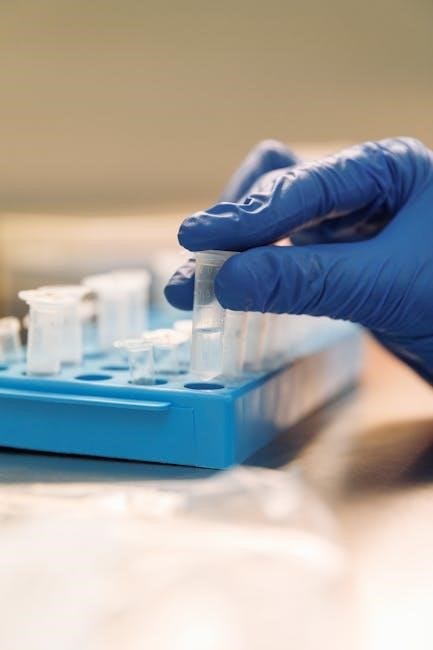
Advanced Laboratory Techniques
This section covers specialized methods like PCR, DNA electrophoresis, and cell culture, providing detailed protocols for complex biological experiments and analyses in a laboratory setting.
PCR is a groundbreaking technique in molecular biology that amplifies specific DNA sequences. It involves repeated cycles of heating and cooling to denature DNA, anneal primers, and extend strands using DNA polymerase. This method is highly sensitive, enabling the generation of millions of copies from a small sample. Applications include genetic testing, forensic analysis, and disease diagnosis. Proper setup, including primer design and temperature optimization, is crucial for successful amplification. Understanding PCR is essential for advanced lab work in genetics and biotechnology, as it forms the basis for many downstream analyses.
DNA Electrophoresis: Principles and Procedures
DNA electrophoresis is a widely used technique to separate DNA fragments by size. It involves placing DNA samples in a gel matrix and applying an electric field, causing fragments to migrate through the gel at rates proportional to their size. The process includes preparing the gel, loading samples with a dye, and running the electrophoresis. Afterward, the gel is stained to visualize the DNA bands. This method is crucial for analyzing genetic material, identifying DNA fragments, and comparing samples in forensic and molecular biology studies. Proper safety protocols, such as handling ethidium bromide, are essential for safe and effective results.
Cell Culture Techniques: Maintenance and Propagation
Cell culture involves growing cells in a controlled laboratory environment, ensuring their survival and propagation. Maintenance requires preparing nutrient-rich media, incubating at optimal temperatures, and monitoring pH levels. Propagation involves subculturing cells by splitting and transferring them to fresh media. Sterile techniques are critical to prevent contamination. Regular observation under a microscope helps assess cell health and density. Proper documentation and labeling ensure traceability. These techniques are essential for research, diagnostics, and biotechnology, enabling the study of cellular behavior, disease modeling, and the production of biological products. Consistent care ensures healthy cell lines for ongoing experiments and applications.
Chromatography: Types and Applications in Biology
Chromatography is a laboratory technique used to separate, identify, and quantify components of a mixture. Common types include gas chromatography, liquid chromatography, paper chromatography, and thin-layer chromatography. In biology, it is widely used for purifying biomolecules like proteins, DNA, and enzymes. Applications include quality control in food and pharmaceutical industries, medical diagnostics, and environmental monitoring for pollutants. Chromatography also plays a key role in research, enabling the study of metabolic pathways and the analysis of complex biological samples. Its versatility makes it an indispensable tool in both academic and industrial settings for precise separation and identification of biological compounds.

Experimental Design and Data Analysis
Experimental design involves formulating hypotheses, identifying variables, and planning procedures to test them. Data analysis includes collecting, organizing, and interpreting results to validate findings and draw conclusions.
Formulating a Hypothesis and Variables
Formulating a hypothesis involves proposing a testable explanation for a biological phenomenon. It requires clear identification of independent, dependent, and control variables. The independent variable is manipulated, while the dependent variable is measured. Control variables must be held constant to ensure unbiased results. A well-defined hypothesis guides experimental design, allowing for precise data collection and analysis. It should be concise and falsifiable, providing a clear direction for experimentation. Properly formulated hypotheses and variables are essential for valid and reliable scientific investigations in biology. This step is crucial for drawing meaningful conclusions.
Designing Controlled Experiments
Designing controlled experiments involves creating a structured setup to test hypotheses. A controlled experiment compares an experimental group with a control group, ensuring all variables except the independent variable are constant. Proper randomization and replication are essential to validate results. The independent variable is manipulated, while the dependent variable is measured. Controlled variables must be held constant to isolate the effect of the independent variable. This design minimizes bias and ensures reliable data collection. Ethical considerations and precise measurements are critical for valid conclusions. A well-designed experiment allows for accurate analysis of cause-and-effect relationships in biological systems.
Collecting and Recording Data
Collecting and recording data accurately is crucial for reliable experimental outcomes. Use appropriate tools and instruments to gather precise measurements. Record observations systematically in a lab notebook, noting dates, descriptions, and results. Maintain consistency in units and formatting for clarity. Include tables, graphs, or diagrams to visualize trends and patterns. Ensure data is objective, avoiding personal interpretations. Label and organize data clearly, referencing variables and procedures. Regularly review recorded data for accuracy and completeness. This systematic approach ensures reproducibility and facilitates meaningful analysis of biological phenomena.

Statistical Analysis of Biological Data
Statistical analysis is essential for interpreting biological data, ensuring results are reliable and valid. Common methods include t-tests, ANOVA, and regression analysis to compare groups or identify trends. Use software like Excel, R, or SPSS to perform calculations and visualize data. Understand p-values and confidence intervals to determine significance. Correlation and variance analyses help assess relationships between variables. Proper statistical techniques validate experimental conclusions, enabling informed decisions. Always document the chosen method, justifying its suitability for the data. This step ensures transparency and reproducibility in biological research, making findings credible and actionable.
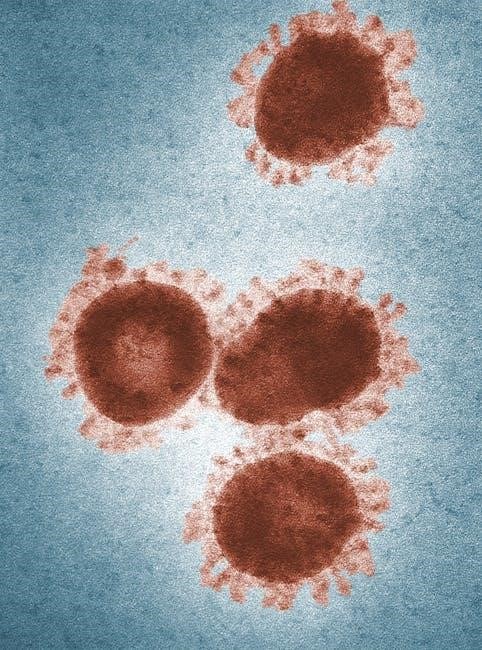
Writing Laboratory Reports
Lab reports communicate scientific findings, detailing methods, results, and conclusions. They follow a structured format, including introduction, methods, results, and discussion, to clearly present experimental outcomes and insights.
A lab report follows a structured format to ensure clarity and effectiveness. The introduction provides background, states the hypothesis, and outlines the experiment’s purpose. The methods section details procedures, materials, and techniques used. The results present data, often through graphs or tables, without interpretation. Finally, the discussion interprets results, relates them to the hypothesis, and discusses implications. This format ensures logical flow, making it easier for readers to understand the experiment’s design, execution, and significance.
Writing the Abstract and Conclusion
Formatting and Style Guidelines for Lab Reports
Lab reports must adhere to specific formatting and style guidelines to ensure clarity and professionalism. Use a standard font, such as Times New Roman (12-point), with double spacing and one-inch margins on all sides. Include a title page with the experiment title, your name, and date. Organize the report into clear sections: introduction, methods, results, discussion, and references. Use headings and subheadings to enhance readability. Properly cite all sources using a recognized citation style, such as APA or MLA. Avoid informal language and ensure precise scientific terminology. Consistency in formatting is crucial for a polished and professional presentation.
Referencing and Citing Sources in Biology
Proper referencing and citing are essential in biology to maintain academic integrity and give credit to original sources. Use recognized citation styles like APA, MLA, or CSE (Council of Science Editors). In-text citations should include the author’s last name and publication year (e.g., Smith, 2021). A reference list at the end must detail all sources, including books, journals, and websites. Ensure accuracy in formatting titles, journal names, and URLs. Plagiarism is a serious offense, so always cite data, images, and ideas that are not your own. Proper citation enhances credibility and adheres to ethical scientific practices.
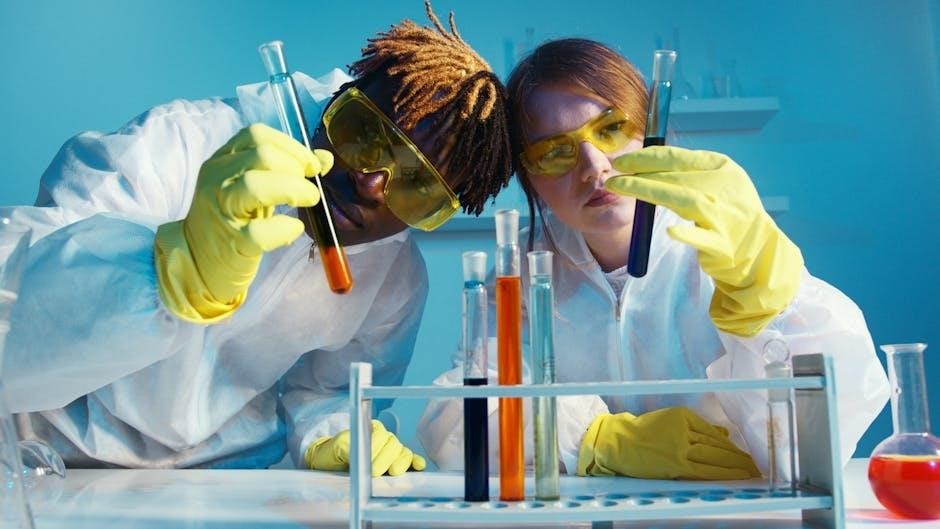
Troubleshooting Common Lab Issues
Troubleshooting is crucial in biology labs to address contamination, experimental errors, or equipment malfunctions. Quick thinking and analytical skills help resolve issues efficiently, ensuring experiment success and safety.
Identifying and Solving Problems in Experiments
Identifying and addressing issues during experiments is crucial for achieving accurate results. Common problems include equipment malfunctions, contamination, or incorrect reagent usage; To solve these, first recognize the issue, then systematically analyze possible causes. Consult lab manuals or instructors for guidance. Implement corrective actions, such as recalibrating instruments or repeating steps with proper protocols. Documenting the problem and solution helps prevent future occurrences. Effective troubleshooting enhances experimental reliability and fosters a deeper understanding of biological principles. It also promotes critical thinking and adaptability in a dynamic lab environment.
Troubleshooting Equipment Malfunctions
Troubleshooting equipment malfunctions in a biology lab requires a systematic approach. First, identify the issue by observing unusual behavior or error messages. Common problems include power failures, faulty wiring, or calibration errors. Check the equipment’s power source and ensure all connections are secure. Consult the user manual for diagnostic guidance or reset procedures. If unresolved, notify lab supervisors or technicians for assistance. Regular maintenance and calibration can prevent malfunctions. Documenting the problem and solution helps improve lab efficiency and ensures equipment reliability for future experiments.
Addressing Contamination and Experimental Errors
Contamination and experimental errors are common challenges in biology labs, requiring immediate attention to ensure reliable results. Identify potential contamination sources, such as unsterilized equipment or improper aseptic technique. Prevent errors by following protocols, using calibrated instruments, and maintaining accurate records. If contamination occurs, discard affected samples and repeat the experiment. Document errors to analyze root causes and implement corrective actions. Regular training and adherence to safety guidelines minimize such issues. Learning from mistakes enhances experimental accuracy and lab efficiency, ensuring the integrity of biological investigations and maintaining a safe working environment for all researchers involved in the process.
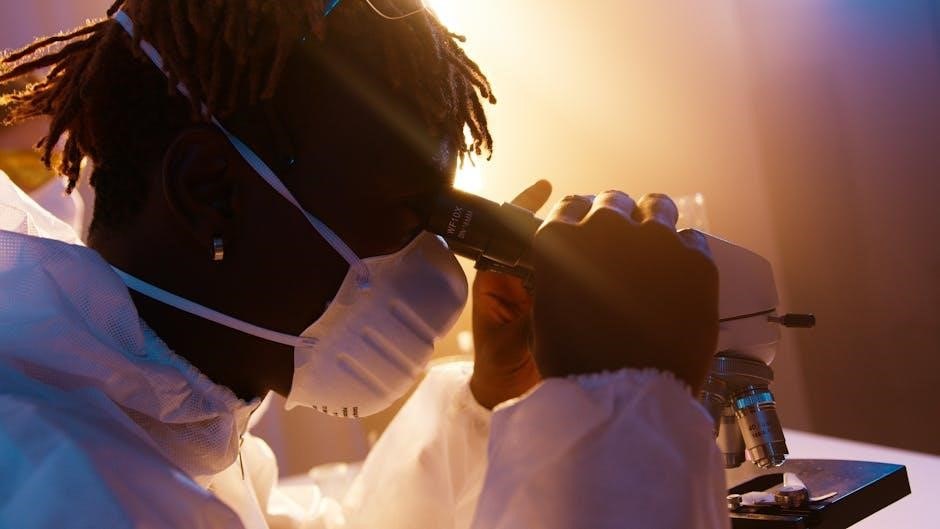
Appendices and Resources
This section provides essential reference materials, including safety data sheets, conversion charts, a glossary of terms, and additional readings to support your laboratory work effectively.
Lab Safety Data Sheets (SDS)
Lab Safety Data Sheets (SDS) are critical documents that provide detailed information about the safe handling, use, storage, and disposal of chemical and biological substances. Each SDS is divided into 16 sections, covering identification, hazards, composition, first aid measures, fire-fighting techniques, accidental release methods, handling and storage, exposure controls, physical and chemical properties, stability, toxicological information, ecological data, disposal considerations, transport information, regulatory information, and other relevant details. These sheets are essential for ensuring compliance with safety regulations and protecting laboratory personnel from potential hazards. Always refer to SDS before working with any new substance in the lab.
Conversion Tables and Measurement Charts
Conversion tables and measurement charts are invaluable resources in a biology lab, providing quick reference for unit conversions, measurement equivalencies, and standardized scales. These tools aid in accurately converting between metric and imperial systems, calculating molar concentrations, and determining pH values. Measurement charts often include calibrated scales for pipettes, burettes, and other lab equipment, ensuring precise measurements. By using these resources, students and researchers can minimize errors, streamline experiments, and maintain consistency in data collection and analysis. They are essential for efficient and accurate laboratory operations, supporting scientific rigor and reproducibility in biological studies.
Glossary of Biological Terms
A glossary of biological terms is a crucial reference section in the lab manual, providing clear definitions of key terminology encountered in biology experiments. It helps students understand complex concepts, ensuring accurate interpretation of procedures and data. The glossary covers terms like “hypothesis,” “variables,” and “sterilization,” offering concise explanations. This resource is particularly useful for newcomers to biology, aiding in the mastery of fundamental principles and techniques. By referencing the glossary, users can clarify doubts and enhance their understanding of biological processes, making it an indispensable tool for effective learning and experimentation in the laboratory setting.
Additional Reading and References
For further exploration, this section provides a curated list of additional resources, including textbooks, scientific articles, and online platforms. Recommended texts like Campbell Biology and Biology: The Core offer in-depth explanations of biological concepts. Journal articles from Nature and Science highlight cutting-edge research. Online resources such as Khan Academy and Coursera courses supplement lab learning. These references enable students to delve deeper into topics, explore advanced techniques, and stay updated on recent discoveries in biology. They also serve as valuable tools for preparing reports and expanding theoretical knowledge beyond the manual.
